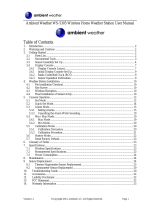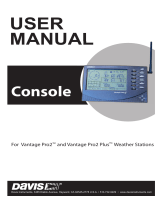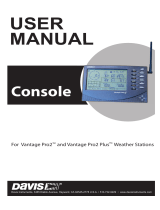Page is loading ...

KTA-250 Anemometer Alarm
KTA-250
KTL-250
• Connects to Davis Instruments DS7911
Anemometer
• Monitor both Wind Speed and Direction
• Interface to PLCs using the Modbus
Protocol
• Communicate via USB or 2-wire RS485
• Interface to PLCs/Instruments or other
controllers using 4-20mA or 0-5V signals
• Generate alarms depending on the Wind
Speed and Direction
• Alarms can be monitored by the on
board SPST Relays or via the Modbus
Protocol
• DIN Rail or Screw Mounting Enclosure
Introduction
The KTA-250 is an anemometer monitoring and alarming card. It allows the wind speed and direction to be
measured with a Davis Instruments DS7911 Anemometer, without the need for the entire weather station.
Monitoring of the wind speed and direction can be done via the analog retransmission channels with 0-5V, 1-5V, 0-
20mA or 4-20mA outputs. As well as monitoring the speed and direction, 2 alarm relays can be programmed to
activate at a certain speed or wind direction range, or combination of the two. Wind speed and direction can also be
monitored using the Modbus protocol with either a USB or 2-wire RS485 connection. Settings are set using the DIP
Switches or Modbus protocol and the provided software.
Connections:
Table 1 - Connections
Connection Description Connection Description
V+ DC Power Input IO1 Wind Speed 0-20mA / 4-20mA / 0-5V
/ 1-5V Re-Transmission Output
COM Common Ground Connection
D+ RS485 Data + IO2 Wind Direction 0-20mA / 4-20mA / 0-
5V / 1-5V Re-Transmission Output
D- RS485 Data -
USB USB Connector REL1 Alarm Relay 1 Contacts
ANEMOM Anemometer Connector
REL2 Alarm Relay 2 Contacts
Table 2 - Holding Registers
Holding
Reg. No.
Description
Holding
Reg. No.
Description
1 Wind Speed 29 Calibration Multiplier
2 Wind Direction 30 Speed Units 0=Mph 1=Km/h 2=Knots 3=m/s
Other=Custom Anemometer Calibration3 Maximum Wind Speed
4 Minimum Wind Speed 31 Speed Transmission Low Value
32 Speed Transmission High Value
10 Relay 1- Wind Speed Alarm On 33 Speed Transmission 0=0-5V/0-20mA
1=1-5V/4-20mA11 Relay 1- Wind Speed Alarm Limit
12 Relay 1-Wind Speed Alarm Period 34 Direction Offset 0-360
13 Relay 1-Wind Dirn Alarm On 35 Direction Transmission 0=0-5V/0-20mA
1=1-5V/4-20mA
14 Relay 1-Wind Dirn < Limit
15 Relay 1-Wind Dirn > Limit 36 Calibrate 1=5V/20mA out on both channels
16 Relay 1-Wind Dirn Alarm Period 37 Modbus Address 1-243
17 Relay 1- Alarm Combination 0=OR,
1=AND
38 Baud Rate 0=9600 1=2400 2=4800 3=9600
4=19200 5=38400 6=57600
39 Parity 0=None 1=Odd 2=Even
20 Relay 2- Wind Speed Alarm On 40 Reset Comms 1=Reset
21 Relay 2- Wind Speed Alarm Limit
22 Relay 2-Wind Speed Alarm Period
23 Relay 2-Wind Dirn Alarm On
24 Relay 2-Wind Dirn < Limit
25 Relay 2-Wind Dirn > Limit
22 Mar 2012 www.oceancontrols.com.au 1 of 5

KTA-250 Anemometer Alarm
26 Relay 2-Wind Dirn Alarm Period
27 Relay 2- Alarm Combination 0=OR,
1=AND
Table 3 - Coils
Coil No. Description Coil No. Description
1 Relay Output 1 10 SW2-1 State
2 Relay Output 2 11 SW2-2 State
3 Force Relay 1 ON 12 SW2-3 State
4 Force Relay 2 ON 13 SW2-4 State
5 Reset Max and Min Speeds 14
15
16 SW1-3 State
17 SW1-4 State
The KTA-250 card only recognises the following Modbus functions:
Table 4 - Recognised Modbus Functions
Function Purpose
1 Read multiple coils
3 Read multiple Holding registers
5 Write to a single coil
6 Write to a single holding register
15 Write to multiple coils
16 Write to multiple holding registers
When reading multiple holding registers, a maximum of 20 holding registers can be read at one time from
the KTA-250.
Communications
The KTA-250 has both a USB and RS485 connection.
USB Virtual COM port drivers can be downloaded from http://www.ftdichip.com/Drivers/VCP.htm
If the KTA-250 is used with RS485 and is the last device on a long run a 100Ω termination resistor should be
installed across the RS485 lines. It should only be inserted for the last node in the network when using long cable
runs and if there are communications problems.
Communications settings of the unit are set by the 4-way DIP switch labelled S2 or Modbus holding registers.
SW1-SW3 control the Modbus address of the unit, SW4 sets the default baud rate (57600) and parity (None). Table
5 shows the effects of the switches.
Table 5 - Comms Setting Selection
S2-1 S2-2 S2-3 Address S2-4 Baud Parity
OFF OFF OFF
Set By
Holding
Reg 37
OFF
Set By
Holding
Reg 38
Set By
Holding
Reg 39
OFF OFF ON 1 ON 57600 None
OFF ON OFF 2
OFF ON ON 3
ON OFF OFF 4
ON OFF ON 5
ON ON OFF 6
ON ON ON 7
If the switches are set to OFF, the communications settings are set via the Modbus holding registers, these default
to Address = 1, Baud Rate = 9600 and Parity = None.
The communications settings are only activated when the unit is first powered up or when a 1 is written to holding
register 40.
If the KTA-250 will not respond to communications, power OFF the unit, set the communications settings to
Address = 1, Baud Rate = 57600 and Parity = None, in the control software, then turn switches S2-3 and S2-4 ON
and S2-1 and S2-2 OFF, after that, turn the power to the unit ON. The control software and the unit should then
communicate.
22 Mar 2012 www.oceancontrols.com.au 2 of 5

KTA-250 Anemometer Alarm
Software
Ocean Controls supply a software configuration package called “KTA-250 Configurator” which is a simple to use
program. The configuration software allows the user to monitor the wind speed and direction, as well as the
maximum and minimum speeds, and allows the user to set all the available settings. Either through the software or
writing to holding register 30 directly the wind speed units can be set. The value by default is Km/H, but can be
changed to MPH with a value of 0, Knots with a value of 2 or m/sec with a value of 3, all other values are MPH.
When the units are set, all parameters to do with wind speed are displayed in these units and the maximum and
minimum speeds are reset.
Figure 2 - Configuration Software
Analog Re-Transmission
The KTA-250 can transmit the wind speed and direction as an analog voltage or current signal. The maximum and
minimum wind speeds to transmit are set using holding registers 31 and 32 and the transmission format (0-20mA /
0-5V or 4-20mA / 1-5V) is set using DIP Switches S1-1 and S1-3.
By default the KTA-250 will transmit from 0 to 100 in Km/H.
Wind direction is output on channel 2, and DIP Switches S1-2 and S1-4 control the format.
Table 6 - Analog Retransmission DIP Switch Settings
SW1-1 SW1-3 Wind Speed
Format
SW1-2 SW1-4 Wind Direction
Format
OFF OFF 0-20mA OFF OFF 0-20mA
OFF ON 4-20mA OFF ON 4-20mA
ON OFF 0-5V ON OFF 0-5V
ON ON 1-5V ON ON 1-5V
22 Mar 2012 www.oceancontrols.com.au 3 of 5
Wind Direction
Wind Speed
Wind Speed
Maximum and
Minimum
Speed Units
Alarm 1 Settings
Alarm 2 Settings
Communications
Settings and
Status

KTA-250 Anemometer Alarm
Current Calibration and Direction Offset
If the anemometer can not be mounted so that the sensor is facing north, or the user does not wish to manually
adjust the sensor, a direction offset can entered to holding register 34 and then this value is added to all direction
readings.
If the user wishes to check the calibration of the current loop transmission a value of 1 should be written to holding
register 36. This will output the 20mA level to both current channels. If it needs to be adjusted, remove the lid of the
KTA-250 case and then a current sensor should be connected to each output and the trimpots near U1 (Channel 1)
and U2 (Channel 2) can be adjusted until exactly 20mA is displayed on the current sensor. Once a satisfactory
calibration has been achieved, holding register 36 should be written back to 0.
Alarms
There are two alarm relays on the KTA-250, each relay can be activated by either the wind speed going over a
certain limit or the direction being within a certain range, or a combination of the two.
The levels and time limits that control the alarms are set using the software or through the Modbus holding
registers. Alarm 1 settings begin at holding register 10 and alarm 2 settings begin at holding register 20. Holding
register 10 enables alarming on wind speed, register 11 is the speed above which the alarm will become active if it
has been above that point for the number of seconds defined by register 12. Register 13 enables alarming on wind
direction. The direction must be less than register 14 and greater than register 15 for the time defined by register
16, to activate the alarm. If register 17 is 0, either speed or direction will activate the relay when the limit is reached,
but when register 17 is 1, both the speed and direction alarms must be active for the relay to turn on.
Alarm relay 2 has the same functionality as alarm relay 1, except the registers associated with it are 20-27 as
opposed to 10-17 for Alarm 1.
Saving Settings to Memory
The KTA-250 has an internal EEPROM memory to store settings even when the unit is not powered. If settings are
changed they are automatically saved to memory. The memory save process occurs approximately 5 seconds after
settings are changed. If settings are changed, wait 10 seconds before removing power from the unit.
Anemometer Calibration
Holding Registers 29 and 30 relate to the way the pulses from the anemometer translate to wind speed.
If the value in Register 30 is any of the values 0, 1, 2 or 3 the wind speed units are set for for the Davis Instruments
7911 Anemometer for Mph, Km/h, Knots and m/s respectively.
A value of 4 or higher will allow for another anemometer to be used, provided it is wired to the connector correctly.
Register 29 is the multipler that is applied to the speed to allow for a greater resolution if a value of 10 is used then
the resolution of the wind speed will be 0.1 of the unit, all the values relating to wind speed will now be a factor of
10 out. Ie, when Register 29 is 10 and Register 30 is 3 a value of 138 in Register 1 will relate to a wind speed of
13.8 m/s.
To create custom calibration units, the value in register 30 should be the number of pulses that the anemometer
gives in one hour for that unit.
For the Davis Instruments 7911 anemometer the values used in the KTA-250 are 1602 for Mph, 995 for Km/h, 1843
for Knots and 3578 for m/s.
Indicator LEDs
Various LEDs are used for feedback on the KTA-250, their function is described in Table 7 below.
Table 7 – Indicator LEDs
LED Description
TX Transmit LED, Active when data is transmitted out of the KTA-250
RX Receive LED, Active when data is received by the KTA-250
RL1 Relay 1 LED, Active when Alarm 1 and Relay 1 are ON
RL2 Relay 2 LED, Active when Alarm 2 and Relay 2 are ON
E1 Error 1 LED, Active when analog output 1 is in current mode and the current loop is disconnected or
overloaded
E2 Error 2 LED, Active when analog output 2 is in current mode and the current loop is disconnected or
overloaded
22 Mar 2012 www.oceancontrols.com.au 4 of 5

KTA-250 Anemometer Alarm
Logging Version
The KTA-250 is also available with a memory chip for logging wind speed and direction data.
Up to approx 65,500 loggings can be made for any combination of “Instantaneous Wind Speed and Direction”,
“Average Wind Speed and Direction” and “Maximum and Minimum Wind Speed” with logging periods of 1 second
to over 2 hours.
The “KTA-250 Log Downloader” software package is used to configure the logging options and download, view and
export logged data from the KTA-250. Check the documentation for the “KTA-250 Log Downloader” Software for
further information.
Logging Memory: 64K loggings
Wind Speed Logging Range: 0 to 255 Km/H
Instantaneous and Average Wind Speed Logging Resolution: 0.5 Km/H
Maximum and Minimum Wind Speed Logging Resolution: 1 Km/H
Instantaneous and Average Wind Direction Logging Resolution: 2.83°
Logging Period: 1 to 8192 seconds
Depending on the number of parameters to log and logging period the logging memory can be filled in as little as 6
hours when logging all parameters at 1 second intervals, or 17 years when logging one parameter at 8192 second
(approx 2 hrs 16 min) intervals.
The “KTA-250 Log Downloader” software has a built in calculator for how long the device will log for.
Selection Guide
OLD Part numbers
Old Part No Description Replaced With
KTA-250 Anemometer Alarm Card, 12V powered without DIN Rail mounting KTA-250-AX
KTB-250 Anemometer Alarm Card, 24V powered without DIN Rail mounting KTA-250-BX
KTE-250 Anemometer Alarm Card, 12V powered with DIN Rail mounting KTA-250-AX
KTD-250 Anemometer Alarm Card, 24V powered with DIN Rail mounting KTA-250-BX
Notes
Prior to June 2011 units shipped will have no analog retransmission of wind speed set by default, this must be
configured by the user.
After June 2011 units shipped should have the following defaults set:
Wind Speed Units Km/H
Wind Speed Transmission Low Value 0
Wind Speed Transmission High Value 100
22 Mar 2012 www.oceancontrols.com.au 5 of 5
KTA-250-ALB
B or Blank: Blue and White Backlit LCD (KTL Only)
G: Green and Black non-Backlit LCD (KTL Only)
L: 64K Logging
X: No Logging
A: 12V Powered
B: 24V Powered
Modbus Anemometer Alarm Unit with DIN Rail Mount
Enclosure
A: Without LCD
L: With LCD
/






